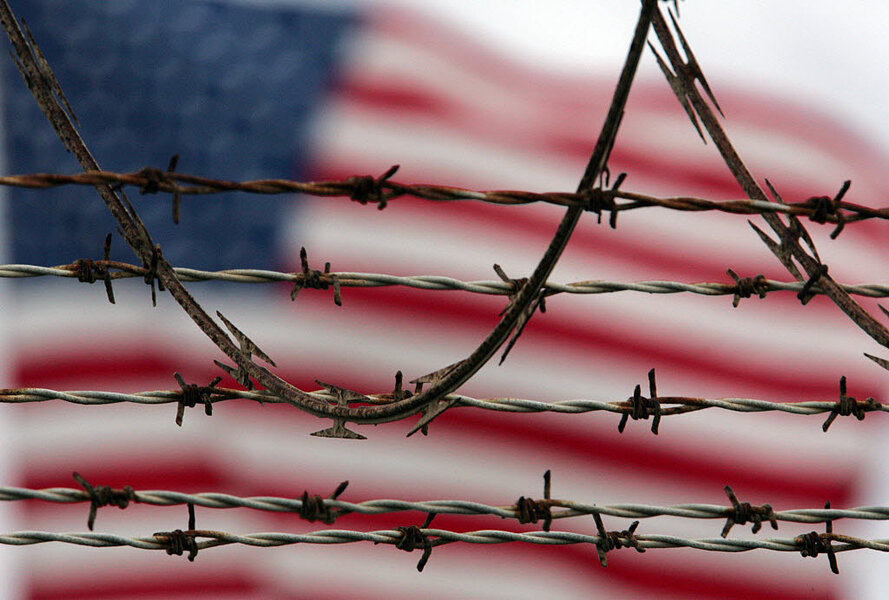'Guantánamo Diary,' written by an inmate, reveals inside look at infamous prison
Loading...
Shortly after the release of the Senate Intelligence Committee’s torture report detailing CIA interrogation tactics used on prisoners, one of the men who was subject to those enhanced interrogations has published a personal account of the treatment he endured at the hands of the CIA.
A decade of legal battles was required before the diary, which was written prior to 2005, could be published Tuesday. The manuscript was originally stamped “SECRET,” a classification level for information that could cause serious damage to national security, and “NOFORN,” meaning it could not be shared with any foreign nationals or intelligence services. It was then kept in a secure facility near Washington, D.C. But attorneys for the author, Mohamedou Ould Slahi, spent years working to have the manuscript cleared for release to the public, the Guardian reported.
The manuscript was cleared for public release in the summer of 2012, after the Defense Department completed an extensive, interagency classification review to ensure that the information in the diary would not harm US personnel or damage US national security. Some 2,500 redactions were made prior to its release, NPR reported.
Its author, meanwhile, remains imprisoned in Guantánamo Bay, Cuba.
Mr. Slahi is a Mauritanian terror suspect who has been in detention in the US prison there since August 2002. Now, after years of being referred to by just a number, Mr. Slahi is offering the American public a description of his experiences and emotions while behind bars. All 466 handwritten pages of Slahi’s personal diary were published on Tuesday by Little, Brown. Reviewers have said "Guantánamo Diary" offers a rare glimpse into the humanity, fear, and resilience of one of the men languishing in the Guantánamo Bay prison camp.
Hina Shamsi, the director of the American Civil Liberties Union's National Security Project called Slahi's "grace, humanity, and humor" throughout his 12-year detention "remarkable," in an interview with CNN Money.
"He has, despite everything that was done to him, great faith in the American public to right the wrongs," Ms. Shamsi said.
Critics have called the book required reading for all Americans concerned with the US's treatment of prisoners during the more than a decade-long battle against terrorism.
"In this new era in which all would be sacrificed to protect the country, torture and even murder of the innocent must be counted simply 'collateral damage,' " Mark Danner wrote in The New York Times Book Review. " 'Guantánamo Diary' is the most profound account yet written of what it is like to be that collateral damage."
Slahi has been held in US custody for more than 12 years. While US officials claim he acted as a recruiter for Al Qaeda beginning in 1991, no formal charges have been brought against him.
The Guantánamo Bay prison camp has been widely criticized for holding inmates indefinitely without charge. President Obama has repeatedly pushed Congress to close the facility. During his State of the Union address on Tuesday, the president reiterated his intent to close the prison, saying, "It makes no sense to spend $3 million per prisoner to keep open a prison that the world condemns and terrorists use to recruit."
In the book, Slahi admits that he pledged allegiance to Al Qaeda in 1991 after spending a year in Afghanistan fighting with the mujahideen – who were US allies at the time – against the Soviet invasion. However, he maintains that he cut all ties with the group after leaving Afghanistan in 1992.
After leaving Afghanistan, Slahi worked in Canada, Germany, and his home country, Mauritania. But after the Mauritanian authorities requested that he turn himself in following the Sept. 11, 2001, attacks on the World Trade Center in New York, Slahi obliged. After renditions to Jordan and Afghanistan, he was transferred to Guantánamo Bay.
Since his detention, Slahi writes, he has suffered from torture through sleep deprivation, freezing, isolation, force-feeding, mock-execution, and other forms of physical and psychological abuse. The first excerpts from the manuscript were published by Slate in April 2013:
“I was just wishing to pass out so I didn't have to suffer, and that was really the main reason for my hunger strike; I knew people like these don't get impressed by hunger strikes. Of course they didn't want me to die, but they understand there are many steps before one dies,” the diary reads.
But the book is not only about torture. Slahi also outlines some of the daily experiences of a prisoner in Guantánamo Bay.
“Breakfast was modest, one boiled egg, a hard piece of bread, and something else I don’t know the name. It was my first hot meal since I left Jordan. Oh, the tea was soothing! People shouting all over the place in indistinct conversations: It was just a good feeling when everybody started to recount his story,” he recounts, according to the excerpts.
Slahi also relates tales of culture shock in his new surroundings, such as an incident in which he was frightened that the CamelBak water bottle a soldier drank from was a potential instrument of torture.
In 2007, the FBI, CIA, and military intelligence officials all conceded that they could not link Slahi to acts of terrorism. A US District Court judge ordered Slahi’s release in 2010. However, a federal appellate court reversed the ruling and the case was sent back to the district court for more hearings. It is unclear when and if Slahi will be released.
[Editor's note: The original version of this story had the accent in the wrong place.]








